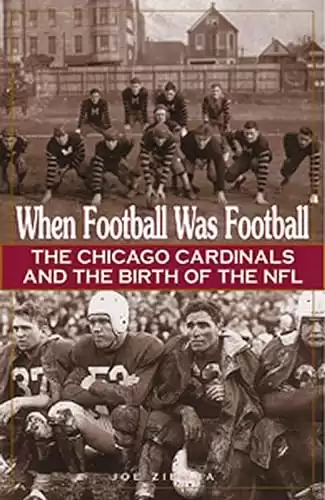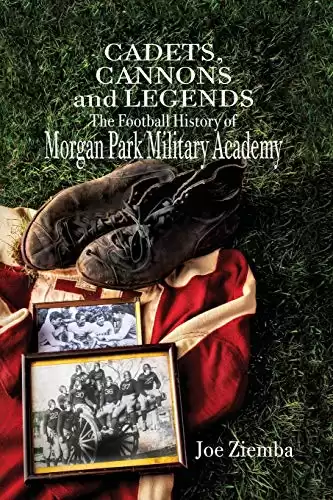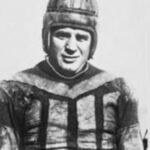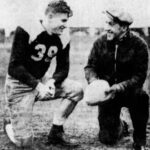For those who remember George Halas, we might think of him in his later years as the aging, but still cranky, coach of the Chicago Bears. Stiff-jawed, intense, and focused, one wonders if Halas ever smiled on the field. From all accounts, he did not! Football was his passion and the urge to play pushed him into pro football in 1919 with the Hammond Bobcats after he told his mother pretty confidently that he “was through with football.”
This followed his break-through season with the Great Lakes Naval Training Center football team which won the Rose Bowl in early 1919. With World War I and the flu epidemic hitting the country in 1918, many college football teams either disbanded or played a reduced schedule. This left military bases, teeming with servicemen who played in high school or college, to fill in the gaps and participate on the football landscape in the fall of 1918.
Halas had not played much football during his tenure at the University of Illinois before joining the Navy in January of 1918. He quickly established himself as a baseball star at Illinois but his gridiron exploits were limited by injuries.
However, this proved beneficial for Halas who spent much of his downtime observing legendary coach Robert Zuppke. Halas was able to see the big picture behind the organization and function of a football team. In his autobiography, Halas discussed Coach Zuppke, stating: “Zuppke was a tremendous coach. He was a careful teacher. He knew how to get the best out of young men. He was an innovator.”
Halas Hired to Coach Staleys
Following his departure from Illinois in early 1918, Halas did play for the talented Great Lakes football team. Then after his discharge from the service, he joined the Hammond Bobcats pro football squad in 1919, while also still pursuing a major league baseball career.
But it was in early 1920 that Halas received the phone call that changed both his life and the direction of professional football. Halas was asked to direct the athletic program and coach the football team for the A.E. Staley Company in Decatur, Illinois. He found the offer attractive and soon traveled down to Decatur from his Chicago home to build a football team.
Over the next decade, Halas oversaw the team’s move to Chicago in 1921, changed its name from the Staleys to the Bears, and won his first pro championship in 1921. Halas welcomed the illustrious Red Grange to the NFL in 1925 and built a solid, reliable winning football club. After finishing 12-1-3 in 1926, the Bears began a slow slide that culminated in a disappointing 4-9-2 mark in 1929, the first losing season in the combined Staleys/Bears history.
Bears Hire High School Coach
With the Great Depression beginning to affect the entire country in 1930, Halas began to question his role as player/coach/owner of the Bears. His initial reaction was to retire as a player. Then, he needed to do something about the co-coaching duties he shared with partner Dutch Sternaman. Halas said:
“The time had come for Dutch and me to stop coaching, or, more accurately, miscoaching. We had to put coaching under one mind. We decided to bring in someone who would pull the team together.”
This would be the first retirement of Halas as the Bears’ coach.
Some may have been surprised when the Bears hired Ralph Jones to take over the team. Jones was coaching at nearby Lake Forest Academy, a high school north of Chicago, which looked to some as a very big jump for a prep leader. Halas and Sternman both knew that Jones carried with him a wealth of knowledge as well as a ton of experience.
Jones had been the freshman coach when both Bears co-owners were at Illinois. He had also served as the head basketball coach at Illinois and Purdue, where he was also an assistant football coach. Jones was a feared adversary at Lake Forest Academy, however, where he compiled a lofty 82-8 record during his ten years at the school.
Even Halas admitted there would be naysayers regarding the hiring: “It astonished everyone that the Bears should go to an academy for a coach. Ralph Jones was a sound strategist. He believed muscle, guts, and spirit were not enough. He believed it also took brains to win games.”
Jones Promises NFL Title In Three Years
Would the first retirement of Halas as a coach result in more failure with a high school coach at the helm, or could new coach Jones reverse the recent tailspin experienced by the Bears? Halas noted that the only stipulation that Jones requested before accepting the offer to coach the Bears was that both Halas and Sternaman stay away from the football field and concentrate on managing the organization. Then, Halas added: “Jones said, ‘I’ll give you a championship in three years.’ I believed him.”
With complete control of all football-related activities, Jones began to carve out a respectable squad in 1930 that reversed the 4-9-2 record of the previous season by finishing 9-4-1, good for third place in the NFL. Halas preferred the old T-formation and Jones maintained that offensive strategy.
However, he initiated some subtle changes such as widening the distance between the offensive linemen and then taking advantage of the little-used man-in-motion opportunity, specifically using the great Red Grange in the backfield. Halas, in admiration, recalled: “In time, Jones had so many plays the defense was totally confused.
Thus was born the modern T-formation with man-in-motion. It broke the game wide open. Football became a game of brains.” Red Grange added: “Playing football became a lot more fun.” As part of using their brains to play the game, Jones also encouraged the Bears players to evaluate their opponents for any insight as to how they might initiate their next play. Halas wrote:
“A linebacker about to blitz the quarterback might place his feet in a different position. A receiver might wipe his hands on his trousers. A passer might look at the intended receiver as the team lined up.” All of these traits were helping Coach Jones create a winning program.
The experiment with hiring high school coach Jones seemed to be working, but would it continue? One big piece to help with the T-formation, and it was a really big piece, also arrived in the Bears’ camp in 1930 in the form of future Hall of Famer Bronko Nagurski. An All-American at both fullback and tackle at the University of Minnesota, Nagurski was a powerful presence on both sides of the line and certainly helped with the initial success enjoyed by coach Jones.
Jones Keeps His Promise
In 1931, the Bears slipped a notch to 8-5, but still good for third place in the league. With just one season to make good on his promise to bring the Bears a championship within three seasons, Coach Jones was ready to push the team to the top of the standings. Although the team was losing money during the depression, Halas and Jones kept the core of the club together for the promising 1932 campaign.
However, the team got off to an ugly start with just an 0-1-3 record after four games. Since tie games still did not count in the official league standings, the Bears faced an intimidating uphill battle in order to challenge for the title. After that rough start, the wins—and the ties–kept piling up for the Bears as they managed to finish with an unusual 6-1-6 record.
The Portsmouth Spartans concluded their schedule with a 6-1-4 mark, thus forcing a playoff for the title since both teams ended with an equal .857 winning percentage with ties being thrown out of the equation. Bad weather forced the championship game to be played indoors at Chicago Stadium where the Bears prevailed by the score of 9-0.
Ralph Jones had delivered on his promise to bring the Bears a championship within three years but then, surprisingly, resigned from his position before the 1933 season forcing Halas to find another head coach. Jones spent just three seasons as the head coach of the Chicago Bears, but his winning percentage of .706 remains the highest for any coach in the team’s long history.
Halas Hires Himself
Although inundated with letters from coaches looking to succeed Jones, Halas needed to look no further than his own mirror to identify the Bears’ next coach. Being it was the depression, Halas also figured out that there would be a significant financial savings by not having to pay a coach in 1933, so he offered himself the job and not surprisingly, accepted!
Halas proved to be quite adept at coaching and the Bears repeated as NFL champions in 1933, and then again under Halas in 1940, 1941, and 1946. While Halas was in the service during WWII, the team also captured the 1943 title. Halas remained in the coaching role until after the 1955 season when the Bears finished 8-4 and in second place in the division.
And it was probably time for the 60-year-old Halas to step away from the rigors of a head coaching position in the NFL and perhaps bring on some young, fresh blood to coach the Bears. Instead, Halas turned the team over to 60-year-old Paddy Driscoll, his old friend, and teammate from both the Great Lakes and the Bears.
Halas said: “I handed the head coaching job to Paddy Driscoll, my friend, and colleague for forty years. I felt I owed him the satisfaction of being head coach before he ended his career. I told Paddy, privately, the job would be his for two years and then I would return.”
Paddy Driscoll Named New Head Coach
On February 2, 1956, Halas made the change official by stating: “Paddy is a solid, dependable football man. I have great confidence in his ability to keep the Bears in the title running. I know of no one who has made a greater contribution to the game of football.” Driscoll, a long-time assistant with the Bears, was pleased with the appointment, calling it “the greatest assignment of his career.”
Driscoll proved to be up to the task by winning the division with a 9-2-1 record and advancing to the 1956 title game against the New York Giants. Then disaster struck as the Giants battered the Bears 47-7 after building up an insurmountable 34-7 halftime lead. The Giants wore gym shoes on the frozen Yankee Stadium field which was reminiscent of the Giants title game victory over the Bears in 1934 in the famous “Sneakers” Game. Some familiar names were announcing the game on NBC that day: Chris Schenkel, Red Grange, and Chicago’s own Jack Brickhouse.
The Final Retirement of George Halas
In 1957, the Bears under Paddy Driscoll slumped to 5-7 and right on cue, Halas returned to coaching in 1958 and remained there through the 1967 season. Halas did win another title in 1963, beating those same Giants. George Halas finally retired on February 27, 1968, and walked away with a lifetime coaching record of 318-148-31 over his incredible 39-year coaching career.
His retirement in 1968 was somewhat of a surprise but Halas explained his reasoning at the time: “I suppose I began to realize this [retirement] in one of our final games last season when I started rushing after the referee who was pacing off a penalty and it suddenly dawned on me that I wasn’t gaining on him! I began to wonder whether the officials were speeding up, or I was slowing down.”
This time, Halas would not return from retirement, but unlike the previous two settings, the Bears did not return quickly to the title game. In fact, it was not until 1985 that the Bears were able to win their next—and last—NFL championship.
Thank you for joining us today for our look at the various “retirements” of coach George Halas. As the NFL schedule begins in earnest shortly, our next episode on the Sports History Network will focus on several “mini” scandals that rocked the NFL without anyone else really taking any notice back When Football Was Football!
Author and Host - Joe Ziemba
Joe Ziemba is the host of this show, and he is an author of early football history in the city of Chicago. Here, you can learn more about Joe and When Football Was Football, including all of the episodes of the podcast.
Please Note – As an Amazon Associate I earn from qualifying purchases
Resources
More From When Football Was Football
Paddy Driscoll’s Almost Perfect Season
Back at the beginning of the National Football League in...
Read More120,000 Fans Witness High School Football Game in 1937!!!
Let’s set the stage… It was a warm November afternoon...
Read MoreIn The Beginning: An Interview With Joseph T. Sternaman
And, you may ask, who is Joseph T. Sternaman? Sternaman...
Read More1948: The Last Hurrah of the Chicago Cardinals
Cardinals’ fans are familiar with the long, sad story concerning...
Read More





2 thoughts on “The Story Of When George Halas Finally Retired For Good”